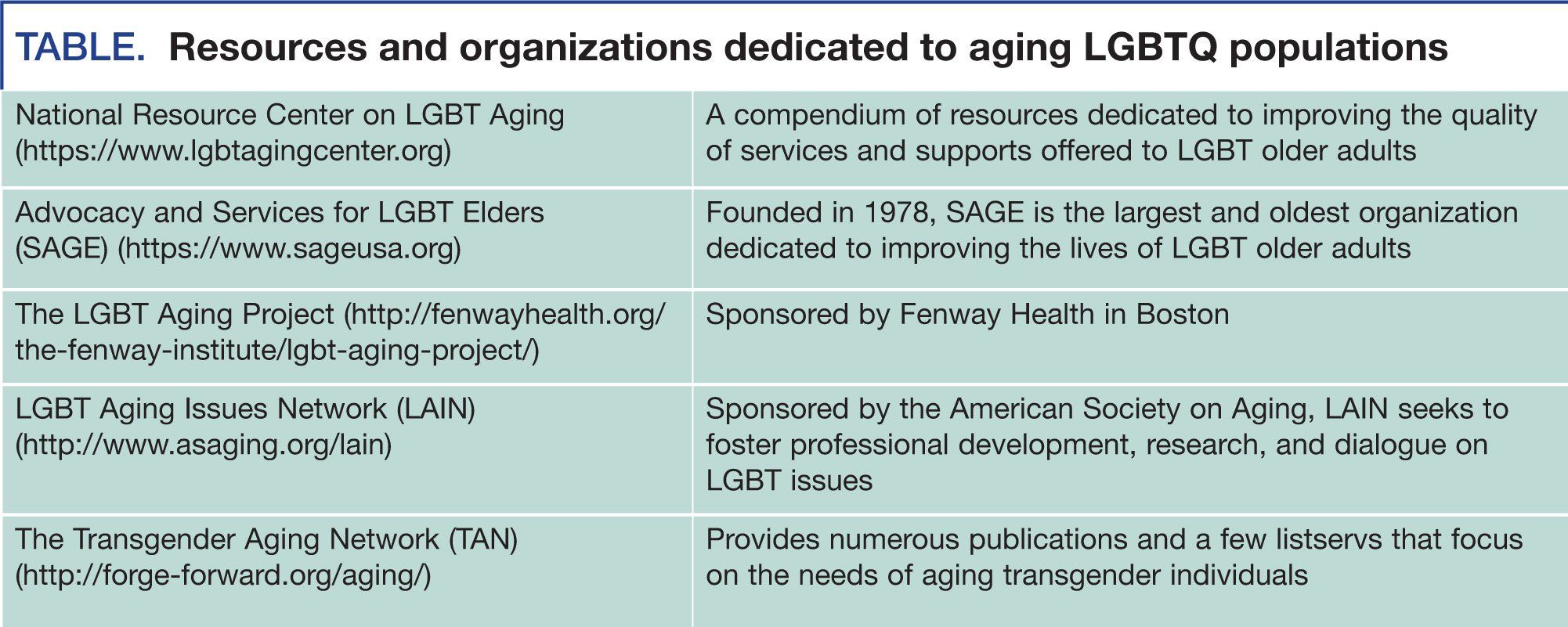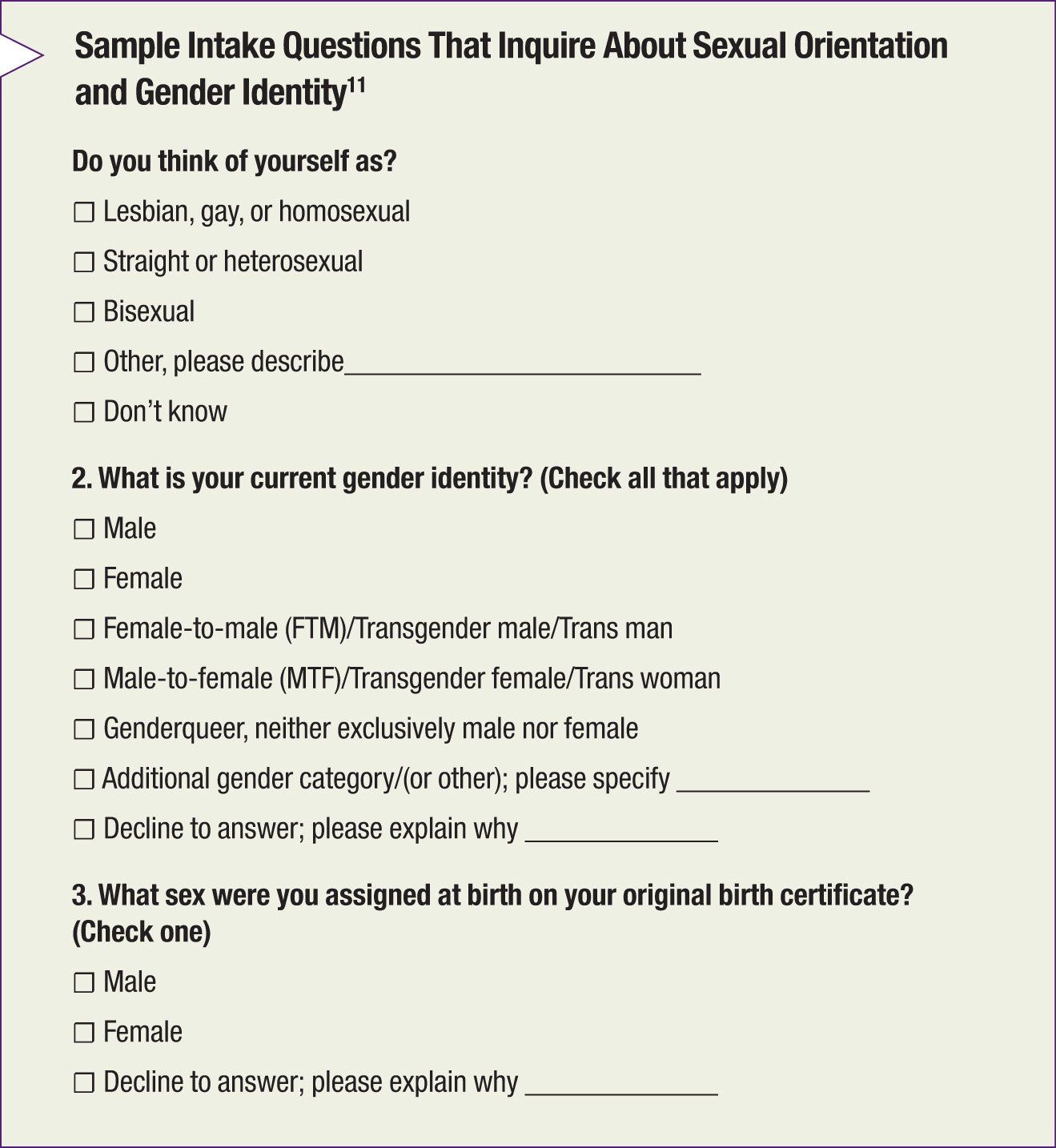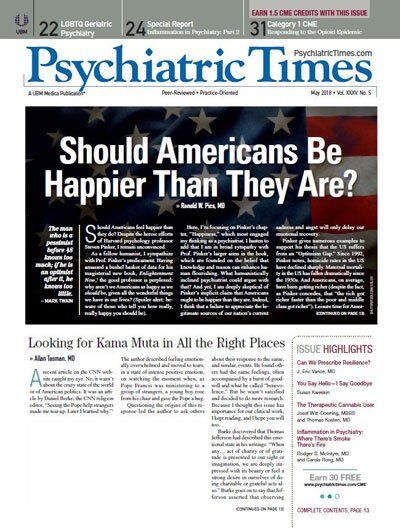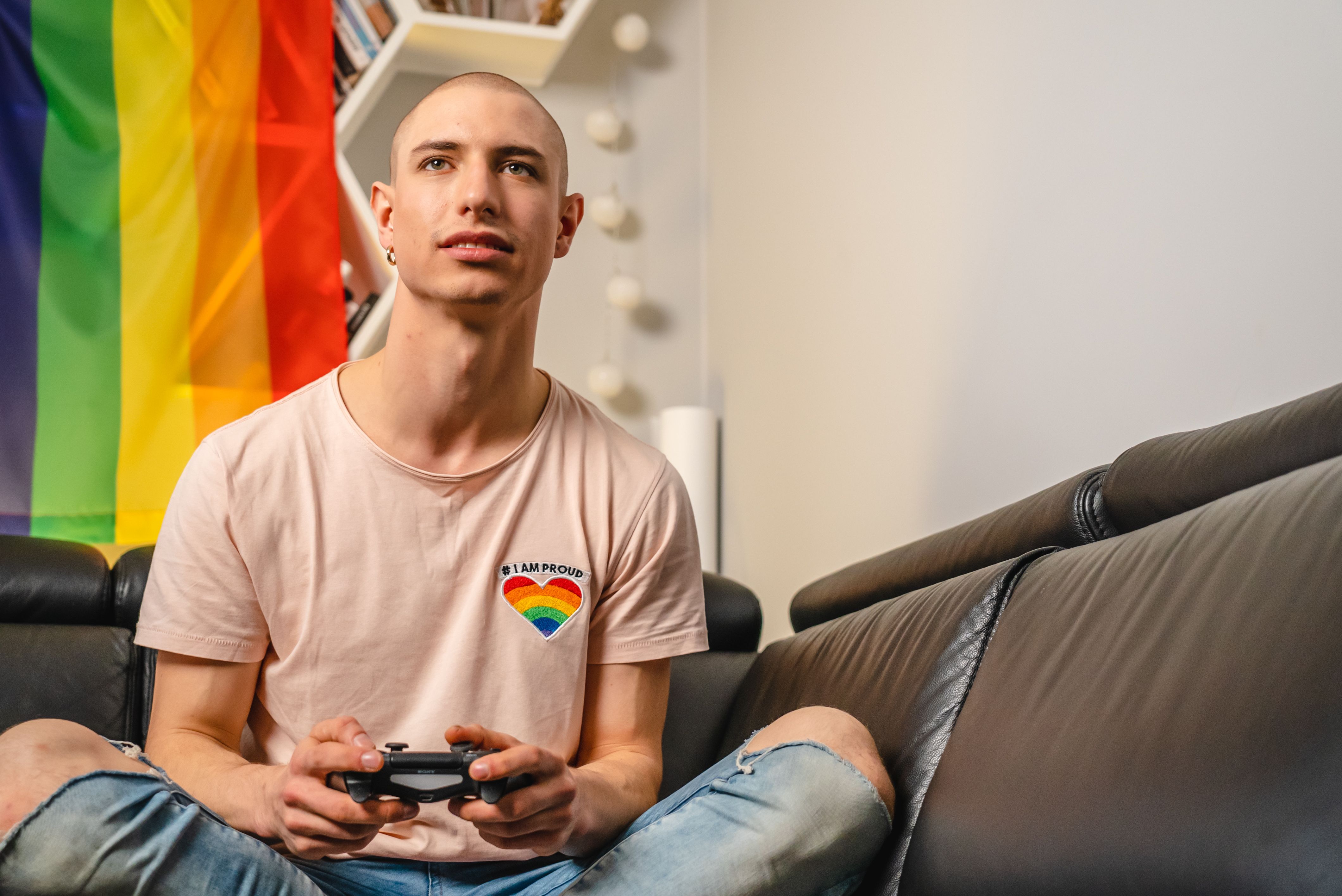Publication
Article
Psychiatric Times
Special Issues in LGBTQ Geriatric Psychiatry
Author(s):
To understand the experiences and needs of the aging LGBTQ population, it is important to consider the culture, politics, and social norms that existed when these elders came of age. Clinicians can play a vital role by creating a safe and open environment that allows people to be themselves.
TABLE. Resources and organizations dedicated to aging LGBTQ populations

There are roughly 1 million lesbian, gay, bisexual, transgender, and queer (LGBTQ) adults who are 65 years or older, and this number is expected to double by 2030.1 They are a vastly diverse group with unique health care needs. However, research on aging LGBTQ populations has been historically neglected. Large-scale surveys have traditionally excluded sexual orientation and gender identity. Before 2000, research was limited to a few small studies.1,2
This began to change after the Institute of Medicine recognized these critical gaps and set federal milestones to change this. Several studies emerged. One of them is Caring and Aging with Pride, a 2010 national study of 2560 LGBTQ adults aged 50 to 95.3 To address research gaps for transgender older adults, the 2015 US Transgender Survey collected data on over 27,000 transgender and gender-nonconforming individuals, more than 500 of whom are older than 65.4
Essential terminology
There are many terms that capture the diversity of the LGBTQ community. Sexual orientation is a broad term used to describe a person to whom someone is physically, emotionally, or romantically attracted. Some may identify as straight, lesbian, gay, bisexual, pansexual, queer, or a number of other sexual orientations. Clinically, it is important to not immediately assume that because one identifies as heterosexual, he or she has not had sexual contact with someone of the same sex-particularly when assessing risk of sexually transmitted infections.
A 2003 New York City survey found that 9.4% of men who identified as heterosexual reported having sexual intercourse with at least one man in the past 12 months.5 The term queer was a slur that has been recently reclaimed by many in the LGBTQ community and can describe those who don’t neatly fit into any sexual or gender categories. It is a controversial term, and it is often avoided by those for whom this still evokes negative connotations. In lieu of the LGBTQ acronym, the US federal government and the National Institutes of Health often use the term sexual and gender minority to be more inclusive.6
Gender or gender identity can be defined as one’s inner sense of being male, female, both, or neither. Sex, however, is generally based on anatomical or biological characteristics, such as genitals, chromosomes, and/or hormones. Gender expression or gender role describes one’s outward manifestation of gender identity, which includes clothing choices, mannerisms, and social interactions. One may identify as transgender if one’s gender identity doesn’t fit with the sex assigned at birth. Cisgender refers to persons whose gender identity matches their sex. Many view gender as a socially constructed binary between male and female; however, this is not the case. There are a growing number of gender-nonconforming, gender-fluid, and non-binary individuals who do not fully identify as male or female and who live outside the gender binary.7
In the clinical encounter, knowing and respecting a patient’s preferred pronouns are essential to creating a safe space. They may be masculine (he/him), feminine (she/her), or gender neutral (ze/hir/singular they). This may or may not match what is indicated in their medical record, so it is important for clinicians to politely inquire if they are unsure.
Historical context
To understand the experiences and needs of the aging LGBTQ population, it is important to consider the culture, politics, and social norms that existed when these elders came of age, because each affects identity development and self-perception. It also teaches us to note important distinctions among different cohorts within the aging LGBTQ population. For example, a significant proportion of the aging LGBTQ population-particularly those born before 1945-came of age in an environment where same-sex behavior was highly stigmatized and illegal in many places. Hiding one’s sexual orientation was essential for survival. This started to change with the Civil Rights Movement and sexual revolution of the 1960s. The Stonewall Inn riots of 1969 led to the growth and expansion of the Gay Liberation Movement in the early 1970s.
In 1973, the American Psychiatric Association removed homosexuality from DSM. Prior to this, it was considered a sociopathic personality disorder that warranted the need for numerous conversion therapies to “cure” individuals with same-sex attractions and/or behaviors. The historic stigmatization of same-sex attraction as a mental illness has led to a lasting distrust and fear of psychiatrists and other health care providers.
In the 1970s, more LGBTQ people came out and became more visible and vocal. Burgeoning gay and lesbian communities grew in major urban hubs. However, in the early 1980s, the rapid spread of HIV and AIDS led to millions of deaths-devastating many communities. Inaction and indifference by government agencies, such as the National Institutes of Health and the FDA, led to the formation of several activist organizations, such as ACT UP, to counter this. It also fueled the assumption that the medical establishment is not to be trusted.
The transgender and gender-nonconforming community has also experienced a long history of stigma, prejudice, and fear. After homosexuality was removed from the DSM, there was a continued pathologization of transgender identities by maintaining the diagnosis of gender identity disorder, which was changed to gender dysphoria in DSM 5.7 Although the existence of a diagnosis is controversial, many argue that it is necessary to compel insurance companies to cover hormone therapy, gender-affirming surgeries, and other treatments. Moreover, there is ongoing conflict between trans patients and clinicians regarding the clinicians’ role as gatekeepers who have traditionally restricted access to medical and surgical interventions. This role can make establishing a therapeutic relationship with trans patients more challenging.
Disparities and minority stress
The existing literature on LGBTQ elders shows higher rates of legal and economic discrimination, rendering them less likely to have sufficient financial resources to care for themselves or to obtain proper health care. LGBTQ older adults are more likely to have poorer mental health: 31% of LGBT elders have symptoms of depression-2 to 3 times higher than the general geriatric population; 39% report having suicidal ideation at some point in their lives. Among the transgender elderly, 48% report symptoms of depression and 71% report a history of suicidal ideation. And, LGB individuals are 2 to 3 times more likely to have a substance use disorder. They are more likely to smoke and engage in excessive drinking and risky sexual behavior. The risk increases among those who report higher levels of internalized homophobia.
LGBTQ older adults also report higher levels of disability and poor physical health. Lesbians and bisexual women are at increased risk for cardiovascular disease, are more likely to be obese, and have a lower likelihood of getting a mammogram than heterosexual women. Gay and bisexual men have higher rates of asthma, hypertension, and HIV infection. The prevalence of HIV infection increases among transgender women, African Americans, and Latinos compared with white LGBTQ older adults.
Minority stress theory conceptualizes this by suggesting that higher levels of social stigma, prejudice, and victimization lead to a greater risk of adverse health effects. This applies to LGBTQ older adults, of whom 82% have experienced at least one lifetime episode of victimization because of actual or perceived sexual and/or gender identity; 64% report at least 3 episodes.3 Fear of discrimination or going back into the closet also serves as a major barrier to seeking health care. Many are reluctant to come out to their clinicians-21% report not revealing their LGBTQ identity to their health care provider. Among bisexuals, this percentage increases. Many cite fear of being treated differently or receiving subpar care because of their sexual orientation or gender identity.
While the literature does not show an increased likelihood of neurocognitive disorders, LGBTQ elders are more likely to lack available caregivers or face risk of discrimination in nursing homes and other care facilities. Compared with their heterosexual counterparts, they are more likely to live alone and less likely to be married and have children, which affects their ability to find dedicated caretakers as they age. Older lesbians and gay men tend to delay entering residential care out of fear of discrimination; 75% believe these facilities do not include anti-discrimination policies, and 34% believe they would have to conceal their sexual orientation to live within the facility.6
Resilience
In spite of the existence of numerous sources of adversity, most aging LGBTQ individuals are in good health, are aging well, have high satisfaction with their lives, and have strong personal and social ties with others.2,8 Some argue they may actually be more equipped to accept aging than their heterosexual counterparts. This may be explained through crisis competence theory, which states that the experience of coping with stigmatization earlier in adulthood (ie, being LGBTQ) may better equip a person to cope with the stigma associated with aging.2
Community also plays a big role in this. In the Caring and Aging with Pride study, 90% of participants report feeling good about belonging to their communities.3 Although LGBT elders are less likely to have biological children, on whom they can rely as caretakers, 75% report having “second families” or “families of choice” that are based on long-term friendship, mutual support, and love; 89% report having at least 3 people they can count on if they encounter a “serious problem.”
Factors that encourage successful aging in LGBTQ adults include having a positive self-identity, socioeconomic resources, access to health care, a life partner, and both informal and community-based supports. Most of the research on resilience focuses on lesbian and gay older adults, and little is known about resilience among bisexual and trans elders; however, one focus group study reveals trans elders build and maintain their resiliency through volunteering, teaching, and engaging in advocacy and LGBTQ events.9
Sample Intake Questions That Inquire About Sexual Orientation and Gender Identity

Creating a safe and welcoming environment
Before the clinical encounter:
1 Educate yourself on the health needs of the aging LGBTQ population. LGBTQ older adults have often needed to educate their clinicians on basic terminology or identities. (See Table for several resources.)
2 Familiarize yourself with the concept of gender diversity and with the evaluative process for gender dysphoria. The Standards of Care, published by the World Professional Association for Transgender Health, is a helpful resource.
3 Educate your nursing and ancillary staff, such as administrative assistants, medical assistants, and security staff. The National LGBT Health Education Center offers online training.
4 Add questions about sexual orientation and gender identity on patient registration forms (Sidebar).
5 Place objects in your office or the waiting room that indicate your office is a safe space-this may include rainbow stickers, pride posters, and related reading materials. LGBTQ patients often look for clues to assure them that coming out is accepted and encouraged.
6 Check whether your institution’s nondiscrimination policies include sexual orientation, gender identity, and gender expression. You can also check to see if your facility is listed in the Healthcare Equality Index, which is a national benchmarking tool sponsored by the Human Rights Campaign.
7 Offer gender-neutral bathrooms for transgender and gender-nonconforming older adults. Some therapists offer a “gender closet,” a safe space where patients can explore different forms of gender expression.
During the clinical encounter, keep in mind the historical context. Older LGBTQ adults consistently report feeling skeptical of health care professionals and reluctant to rely on a system that has traditionally discriminated against them. It may take some additional effort to gain their trust. When asking about sexual orientation or gender identity, ask relevant questions with explanations about why the information is needed to avoid the perception of intrusion or excessive curiosity. Remember that not every LGBT patient-even when asked-will disclose true sexual orientation or gender identity at first.
Don’t assume patients are heterosexual or cisgender. Clinical questions should be inclusive and avoid making assumptions about the patient’s sexual behavior or relationships. For example, when asking about relationship status, avoid gendered words such as “husband” or “wife.” Ask patients what pronouns they use (masculine/feminine/gender neutral) and apologize if you accidentally use the wrong one.
Explore risk factors for poorer physical and/or mental health, including history of victimization and trauma, internalized stigma, long-term concealment of sexual identity or gender identity, isolation, and lack of connection to the LGBTQ community. Explore existing or potential protective factors such as active involvement with community and/or religious organizations (not necessarily LGBTQ oriented), existence of positive coping mechanisms, having a positive sense of sexual or gender identity, and having adequate financial and health care resources.
If relevant, explore if, when, and how they came out, and discuss any concerns or fears about being out and aging. If they are out, explore their relationship with the LGBTQ community. Ask about past experiences of victimization and loss related to their LGBTQ identity-including whether they have ever been coerced or forced into psychiatric treatment, subjected to some form of conversion therapy, lost family or friends to HIV infection or other illnesses, or lost relationships and friendships because of being LGBTQ.
Encourage patients to prepare an advance directive or living will that can inform others of their wishes should they be unable to make decisions for themselves. This is particularly important for LGBTQ elders because same-sex partners are sometimes not given automatic next-of-kin status in hospitals. These documents can also request that medical staff respect the person’s gender identity and gender expression while incapacitated. Sample templates can be found on The Transgender Law Center website.10
Conclusion
The aging LGBTQ population consists of numerous diverse, rich, and complex communities. While there are increased rates of depression and substance use disorders and increased reports of victimization and discrimination, there is also strong evidence of resilience and high rates of successful aging. Regardless, clinicians can play a vital role by creating a safe and open environment that allows people to be themselves.
Disclosures:
Dr. Johnson is a Resident, Department of Psychiatry, Yale University School of Medicine, New Haven, CT.
Dr. Johnson is an unpaid board member of Trans Bodies Trans Selves, a 501c3 nonprofit that is dedicated to empowering trans communities and publishes Trans Bodies, Trans Selves: A Resource for the Transgender Community.
References:
1. Yarns BC, Abrams JM, Meeks TW, et al. The mental health of older LGBT adults. Curr Psychiatry Rep. 2016;18:60.
2. Fredriksen-Goldsen KI, Muraco A. Aging and sexual orientation: a 25-year review of the literature. Res Aging.2010;32:372-413.
3. Fredriksen-Goldsen KI, Kim HJ, Emlet CA, et al. The aging and health report: disparities and resilience among lesbian, gay, bisexual, and transgender older adults. 2011. http://depts.washington.edu/agepride/wordpress/wp-content/uploads/2012/10/Full-report10-25-12.pdf. Accessed December 7, 2017.
4. James SE, Herman JL, Rankin S, et al. The report of the 2015 US transgender survey. Washington, DC: National Center for Transgender Equality; 2016.
5. Pathela P, Hajat A, Schillinger J, et al. Discordance between sexual behavior and self-reported sexual identity: a population-based survey of New York City men. Ann Intern Med. 2006;145:416-425.
6. Choi SK, Ilan M. LGBT Aging: A Review of Research Findings, Needs, and Policy Implications. The Williams Institute. 2016. https://williamsinstitute.law.ucla.edu/wp-content/uploads/LGBT-Aging-A-Review.pdf. Accessed December 7, 2017.
7. Erickson-Schroth L. Trans Bodies, Trans Selves: A Resource for the Transgender Community. Oxford, UK: Oxford University Press; 2014.
8. Fredriksen-Goldsen KI. Despite disparities, most LGBT elders are aging well. Aging Today. 2014. https://www.ncbi.nlm.nih.gov/pmc/articles/PMC4243168/. Accessed December 7, 2017.
9. Elder A. Experiences of older transgender and gender nonconforming adults in psychotherapy: a qualitative study. Psychol Sex Orient Gender Diver. 2016;3:180-186.
10. National Center on LGBT Aging, Whitman-Walker Health: Creating End-of-Life Documents for Trans Individuals: An Advocate’s Guide. 2014. https://www.whitman-walker.org/wp-content/uploads/2015/02/End-of-Life-PlanningArticle.pdf. Accessed December 7, 2017.
11.Cahill S, Singal R, Grasso C, et al. Do ask, do tell: high levels of acceptability by patients of routine collection of sexual orientation and gender identity data in four diverse American community health centers. PLoS One. 2014;9:e107104.







